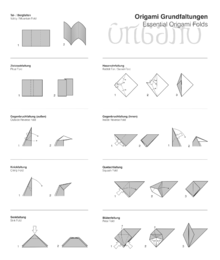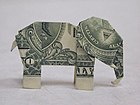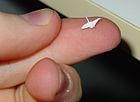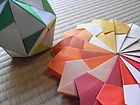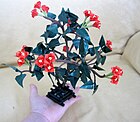Origami (8/2)
Posted on February 8, 2014
Origami (折り紙, from ori meaning “folding”, and kami meaning “paper” (kami changes to gami due to rendaku) is the traditional Japanese art of paper folding, which started in the 17th century AD at the latest and was popularized outside of Japan in the mid-1900s. It has since evolved into a modern art form. The goal of this art is to transform a flat sheet of paper into a finished sculpture through folding and sculpting techniques, and as such the use of cuts or glue are not considered to be origami. Paper cutting and gluing is usually considered kirigami.
The number of basic origami folds is small, but they can be combined in a variety of ways to make intricate designs. The best known origami model is probably the Japanese paper crane. In general, these designs begin with a square sheet of paper whose sides may be different colors or prints. Traditional Japanese origami, which has been practiced since the Edo era (1603–1867), has often been less strict about these conventions, sometimes cutting the paper or using nonsquare shapes to start with.
The principles of origami are also used in stents, packaging and other engineering structures.
History
There is much speculation about the origin of Origami. While Japan seems to have had the most extensive tradition, there is evidence of an independent tradition of paperfolding in China, as well as in Germany, Italy and Spain, among other places. However, because of the problems associated with preserving origami, there is very little direct evidence of its age or origins, aside from references in published material.
In China, traditional funerals include burning folded paper, most often representations of gold nuggets (yuanbao). It is not clear when this practice actually started, but it seems to have become popular during the Sung Dynasty (905–1125 CE). The paper folding has typically been of objects like dishes, hats or boats rather than animals or flowers.
The earliest evidence of paperfolding in Europe is a picture of a small paper boat in Tractatus de sphaera mundi, a textbook on astronomy, from 1490. There is also evidence of a cut and folded paper box from 1440. It is probable that paperfolding in the west originated with theMoors much earlier; it is not known if it was independently discovered or knowledge of origami came along the silk route.
In Japan, the earliest unambiguous reference to a paper model is in a short poem by Ihara Saikaku in 1680 which describes paper butterflies in a dream. Origami butterflies were used during the celebration of Shinto weddings to represent the bride and groom, so paperfolding had already become a significant aspect of Japanese ceremony by the Heian period (794–1185) of Japanese history, enough that the reference in this poem would be recognized. Samurai warriors would exchange gifts adorned with noshi, a sort of good luck token made of folded strips of paper.
In the early 1900s, Akira Yoshizawa, Kosho Uchiyama, and others began creating and recording original origami works. Akira Yoshizawa in particular was responsible for a number of innovations, such as wet-folding and the Yoshizawa–Randlett diagramming system, and his work inspired a renaissance of the art form. During the 1980s a number of folders started systematically studying the mathematical properties of folded forms, which led to a steady increase in the complexity of origami models, which continued well into the 1990s, after which some designers started returning to simpler forms
Techniques and materials
Techniques
Many origami books begin with a description of basic origami techniques which are used to construct the models. This includes simple diagrams of basic folds like valley and mountain folds, pleats, reverse folds, squash folds, and sinks. There are also standard named bases which are used in a wide variety of models, for instance the bird base is an intermediate stage in the construction of the flapping bird.Additional bases are the preliminary base (square base), fish base, waterbomb base, and the frog base.
Origami paper
Almost any laminar (flat) material can be used for folding; the only requirement is that it should hold a crease.
Origami paper, often referred to as “kami” (Japanese for paper), is sold in prepackaged squares of various sizes ranging from 2.5 cm (1 in) to 25 cm (10 in) or more. It is commonly colored on one side and white on the other; however, dual coloured and patterned versions exist and can be used effectively for color-changed models. Origami paper weighs slightly less than copy paper, making it suitable for a wider range of models.
Normal copy paper with weights of 70–90 g/m2 can be used for simple folds, such as the crane and waterbomb. Heavier weight papers of (19–24&nb 100 g/m2 (approx. 25 lb) or more can be wet-folded. This technique allows for a more rounded sculpting of the model, which becomes rigid and sturdy when it is dry.
Foil-backed paper, as its name implies, is a sheet of thin foil glued to a sheet of thin paper. Related to this is tissue foil, which is made by gluing a thin piece of tissue paper to kitchen aluminium foil. A second piece of tissue can be glued onto the reverse side to produce a tissue/foil/tissue sandwich. Foil-backed paper is available commercially, but not tissue foil; it must be handmade. Both types of foil materials are suitable for complex models.
Washi (和紙) is the traditional origami paper used in Japan. Washi is generally tougher than ordinary paper made from wood pulp, and is used in many traditional arts. Washi is commonly made using fibres from the bark of the gampi tree, the mitsumata shrub (Edgeworthia papyrifera), or thepaper mulberry but can also be made using bamboo, hemp, rice, and wheat.
Artisan papers such as unryu, lokta, hanji , gampi, kozo, saa, and abaca have long fibers and are often extremely strong. As these papers are floppy to start with, they are often backcoated or resized with methylcellulose or wheat paste before folding. Also, these papers are extremely thin and compressible, allowing for thin, narrowed limbs as in the case of insect models.
Paper money from various countries is also popular to create origami with; this is known variously as Dollar Origami, Orikane, and Money Origami.
Tools

Bone folders
It is common to fold using a flat surface, but some folders like doing it in the air with no tools, especially when displaying the folding. Many folders believe that no tool should be used when folding. However a couple of tools can help especially with the more complex models. For instance a bone folder allows sharp creases to be made in the paper easily, paper clips can act as extra pairs of fingers, and tweezers can be used to make small folds. When making complex models from origami crease patterns, it can help to use a ruler and ballpoint embosser to score the creases. Completed models can be sprayed so they keep their shape better, and a spray is needed when wet folding.
Types of origami
Action origami
Origami not only covers still-life, there are also moving objects; Origami can move in clever ways. Action origami includes origami that flies, requires inflation to complete, or, when complete, uses the kinetic energy of a person’s hands, applied at a certain region on the model, to move another flap or limb. Some argue that, strictly speaking, only the latter is really “recognized” as action origami. Action origami, first appearing with the traditional Japanese flapping bird, is quite common. One example is Robert Lang’s instrumentalists; when the figures’ heads are pulled away from their bodies, their hands will move, resembling the playing of music.
Modular origami
Modular origami consists of putting a number of identical pieces together to form a complete model. Normally the individual pieces are simple but the final assembly may be tricky. Many of the modular origami models are decorative balls like kusudama, the technique differs though in that kusudama allows the pieces to be put together using thread or glue.
Chinese paper folding includes a style called Golden Venture Folding where large numbers of pieces are put together to make elaborate models. It is most commonly known as “3d origami”, however, that name did not appear until Joie Staff published a series of books titled “3D Origami”, “More 3D Origami”, and “More and More 3D Origami”. Sometimes paper money is used for the modules. This style originated from some Chinese refugees while they were detained in America and is also called Golden Venture folding from the ship they came on.
Wet-folding
Wet-folding is an origami technique for producing models with gentle curves rather than geometric straight folds and flat surfaces. The paper is dampened so it can be moulded easily, the final model keeps its shape when it dries. It can be used, for instance, to produce very natural looking animal models. Size, an adhesive that is crisp and hard when dry, but dissolves in water when wet and becoming soft and flexible, is often applied to the paper either at the pulp stage while the paper is being formed, or on the surface of a ready sheet of paper. The latter method is called external sizing and most commonly uses Methylcellulose, or MC, paste, or various plant starches.
Pureland origami
Pureland origami is origami with the restriction that only one fold may be done at a time, more complex folds like reverse folds are not allowed, and all folds have straightforward locations. It was developed by John Smith in the 1970s to help inexperienced folders or those with limited motor skills. Some designers also like the challenge of creating good models within the very strict constraints.
Origami tessellations
This branch of origami is one that has grown in popularity recently. A tessellation is a collection of figures filling a plane with no gaps or overlaps. In origami tessellations, pleats are used to connect molecules such as twist folds together in a repeating fashion.
During the 1960s, Shuzo Fujimoto was the first to explore twist fold tessellations in any systematic way, coming up with dozens of patterns and establishing the genre in the origami mainstream. Around the same time period, Ron Resch patented some tessellation patterns as part of his explorations into kinetic sculpture and developable surfaces, although his work was not known by the origami community until the 1980s. Chris Palmer is an artist who has extensively explored tessellations after seeing the Zilij patterns in the Alhambra, and has found ways to create detailed origami tessellations out of silk. Robert Lang and Alex Bateman are two designers who use computer programs to create origami tessellations.
Kirigami
Kirigami is a Japanese term for paper cutting. Cutting was often used in traditional Japanese origami, but modern innovations in technique have made the use of cuts unnecessary. Most origami designers no longer consider models with cuts to be origami, instead using the term Kirigami to describe them. This change in attitude occurred during the 1960s and 70s, so early origami books often use cuts, but for the most part they have disappeared from the modern origami repertoire; most modern books don’t even mention cutting.
Mathematics and technical origami
Mathematics and practical applications
The practice and study of origami encapsulates several subjects of mathematical interest. For instance, the problem of flat-foldability (whether a crease pattern can be folded into a 2-dimensional model) has been a topic of considerable mathematical study.
A number of technological advances have come from insights obtained through paper folding. For example, techniques have been developed for the deployment of car airbags and stent implants from a folded position.
The problem of rigid origami (“if we replaced the paper with sheet metal and had hinges in place of the crease lines, could we still fold the model?”) has great practical importance. For example, the Miura map fold is a rigid fold that has been used to deploy large solar panel arrays for space satellites.
Origami can be used to construct various geometrical designs not possible with compass and straightedge constructions. For instance paper folding may be used for angle trisection and doubling the cube.
There are plans for an origami airplane to be launched from space. A prototype passed a durability test in a wind tunnel on March 2008, and Japan’s space agency adopted it for feasibility studies.
Technical origami
Technical origami, also known as origami sekkei (折り紙設計), is a field of origami that has developed almost hand-in-hand with the field of mathematical origami. In the early days of origami, development of new designs was largely a mix of trial-and-error, luck and serendipity. With advances in origami mathematics however, the basic structure of a new origami model can be theoretically plotted out on paper before any actual folding even occurs. This method of origami design was developed by Robert Lang, Meguro Toshiyuki and others, and allows for the creation of extremely complex multi-limbed models such as many-legged centipedes, human figures with a full complement of fingers and toes, and the like.
The main starting point for such technical designs is the crease pattern (often abbreviated as CP), which is essentially the layout of the creases required to form the final model. Although not intended as a substitute for diagrams, folding from crease patterns is starting to gain in popularity, partly because of the challenge of being able to ‘crack’ the pattern, and also partly because the crease pattern is often the only resource available to fold a given model, should the designer choose not to produce diagrams. Still, there are many cases in which designers wish to sequence the steps of their models but lack the means to design clear diagrams. Such origamists occasionally resort to the sequenced crease pattern (SCP) which is a set of crease patterns showing the creases up to each respective fold. The SCP eliminates the need for diagramming programs or artistic ability while maintaining the step-by-step process for other folders to see. Another name for the sequenced crease pattern is the progressive crease pattern (PCP).
Paradoxically enough, when origami designers come up with a crease pattern for a new design, the majority of the smaller creases are relatively unimportant and added only towards the completion of the crease pattern. What is more important is the allocation of regions of the paper and how these are mapped to the structure of the object being designed. For a specific class of origami bases known as ‘uniaxial bases’, the pattern of allocations is referred to as the ‘circle-packing’. Using optimization algorithms, a circle-packing figure can be computed for any uniaxial base of arbitrary complexity. Once this figure is computed, the creases which are then used to obtain the base structure can be added. This is not a unique mathematical process, hence it is possible for two designs to have the same circle-packing, and yet different crease pattern structures.
As a circle encloses the maximum amount of area for a given perimeter, circle packing allows for maximum efficiency in terms of paper usage. However, other polygonal shapes can be used to solve the packing problem as well. The use of polygonal shapes other than circles is often motivated by the desire to find easily locatable creases (such as multiples of 22.5 degrees) and hence an easier folding sequence as well. One popular offshoot of the circle packing method is box-pleating, where squares are used instead of circles. As a result, the crease pattern that arises from this method contains only 45 and 90 degree angles, which makes for easier folding.
A number of computer aids to origami such as TreeMaker and Oripa, have been devised. Treemaker allows new origami bases to be designed for special purposes and Oripa tries to calculate the folded shape from the crease pattern.
Ethics
Copyright in origami designs and the use of models has become an increasingly important issue as the internet has made the sale and distribution of pirated designs very easy. It is considered good ethics to always credit the original artist and the folder when displaying origami models. All commercial rights to designs and models are typically reserved by origami artists. Normally a person who folds a model using a legally obtained design can publicly display the model unless such rights are specifically reserved, however folding a design for money or commercial use of a photo for instance would require consent. It can be difficult to contact individual designers for permission or payment therefore there is a drive to set up a group to ease such issues.
Gallery
These pictures show examples of various types of origami.
» Filed Under Activity report
Comments
Leave a Reply
You must be logged in to post a comment.
